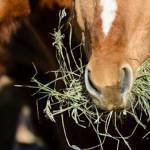Phytoestrogens in Mare Plasma After Ingestion of Legume Products

Little is known about the reproductive effects of plant estrogens in the diet of horses, but it has been identified as a problem in humans. Plant estrogens, also known as phytoestrogens, are commonly found in high amounts in leguminous plant species that are prominent in the diet of horses. At the recent 6th European Workshop on Equine Nutrition (EWEN) in Lisbon, Portugal, researchers from Portugal in collaboration with others in Poland presented their work on absorption of phytoestrogens in mares on clover-mixed pastures and alfalfa (lucerne) pellets.
Phytoestrogens are estrogenic compounds found in plants, and are especially high in legumes such as soy, clover, and alfalfa. They are very similar in structure with endogenous estrogen (17-B-estradiol) formed in the body, but phytoestrogens compete for binding sites on estrogen receptors. Once bound on receptors, phytoestrogens do not have the same action as endogenous estrogen and can act as endocrine disruptors, negatively influencing several endocrine mechanisms during the estrous cycle.
In the first part of this study, 14 Lusitano mares kept on clover and grass pastures had blood samples drawn at monthly intervals for 3 months, and pasture samples were taken at the same time. Both blood plasma and pasture samples were analyzed for the phytoestrogens coumestrol and metabolite 4-methoxycoumestrol by HPLC. Researchers found a difference in the concentration of phytoestrogens in clover through the seasons with the highest levels shown during the warmer growing season and lowest during the cooler months. In the mare’s plasma, there were active forms of coumestrol found in all samples; however, the concentration directly reflected the abundance in the pasture.
In the second part of the experiment, 6 other Lusitano mares were maintained in stalls for 14 days and fed increasing amounts of alfalfa pellets (from 250 g to 1 kg). Alfalfa pellets were analyzed for phytoestrogen content. Blood samples were taken before feeding the alfalfa and at the end of the 2 weeks, and were analyzed for the same active and free forms of coumestrol. On days 13 and 14, a dose response was done by feeding 1 kg alfalfa and taking blood samples every 30 minutes for 8 hours. The results showed a definite increase in plasma coumestrol with ingestion of alfalfa and found plasma phytoestrogens peak between 30 minutes and 5 hours in the bloodstream.
Now that this research has established that phytoestrogens from legumes are found in the bloodstream after ingestion in mares and that the amount is relative to the quantity in the forage, further work to understand the possible effects on endogenous hormone secretion needs to be done.
Botelho, M., M.R. Rebordao, A.M. Balvao, et al. 2012. Phytoestrogen coumestrol and its metabolite in mares’ plasma after clover mixed pasture and alfalfa pellets ingestion. AAEP Publication 132:49-52.








